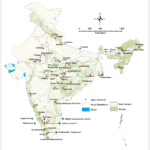Supreme Court Affirms: Free Speech is the Pillar of a Healthy Society

On Friday The Supreme Court of India delivered a landmark judgement on the protection of free speech in India. It quashed a Gujarat Police case against Congress Member of Parliament (MP) Imran Pratapgarhi over a poem uploaded by him on social media.
- The verdict says courts duty-bound to uphold, enforce fundamental rights
- It reiterates that said freedom of expression was an “integral part” of a healthy civilised society. Without it, it is impossible to lead a dignified life guaranteed under Article 21 of the Constitution.
- “Reasonable restrictions” on free speech remain “reasonable and not fanciful and obstructive”.
LEARNING FROM HOME/ FROM CLASSES/ BASICS
Article 19 in The Constitution Of India
The idea behind this article is to give voice to the Indian citizens. The license to express thoughts with some reasonable restrictions.
The principle behind freedom of speech and expressions is as under:
- Only the Indian citizen the liberty to enjoy this right. The right isn’t given any foreign citizen.
- This right gives liberty to express one’s view through any medium e.g.:-by words in writing speaking, in pictures etc.
- The freedom of speech and expression is not an absolute right. The government given powers to frame law for and against it.
- Protection of certain rights regarding freedom of speech etc
(1) All citizens shall have the right
(a) to freedom of speech and expression;
(b) to assemble peaceably and without arms;
(c) to form associations or unions;
(d) to move freely throughout the territory of India;
(e) to reside and settle in any part of the territory of India;
and
(f) omitted
(g) to practise any profession, or to carry on any occupation, trade or business
(2) Imposes reasonable restrictions on the exercise of the right conferred by the said sub clause in the interests of the sovereignty and integrity of India, the security of the State, friendly relations with foreign States, public order, decency or morality or in relation
to contempt of court, defamation or incitement to an offence
Although Article 19 does not express provision for freedom of protest. Bbut the fundamental right of the freedom of protest implicit in the right the freedom of speech and expression.
Article 19 which guarantees freedom of speech and expression a right invoked against the state. Some fundamental rights such as those prohibiting untouchability, trafficking and bonded labour are explicitly against both the state and other individuals.
The Supreme Court, also referred to several foreign jurisdictions, noted a shift in US law from a “purely vertical approach” to a “horizontal approach”.
A vertical application of rights would mean can enforced only against the state while a horizontal approach would mean it enforceable against other citizens.
For example, a horizontal application of the right to life would enable a citizen to bring a case against a private entity for causing pollution, which would be a violation of the right
to a clean environment.






0 Comments